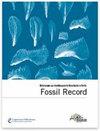Carbon isotope signatures of latest Permian marine successions of the Southern Alps suggest a continental runoff pulse enriched in land plant material
Sonja H. Kraus, Rainer Brandner, Christoph Heubeck, Heinz W. Kozur, Ulrich Struck, Christoph Korte
下载PDF
{"title":"Carbon isotope signatures of latest Permian marine successions of the Southern Alps suggest a continental runoff pulse enriched in land plant material","authors":"Sonja H. Kraus, Rainer Brandner, Christoph Heubeck, Heinz W. Kozur, Ulrich Struck, Christoph Korte","doi":"10.1002/mmng.201300004","DOIUrl":null,"url":null,"abstract":"<p>The latest Permian mass extinction, the most severe Phanerozoic biotic crisis, is marked by dramatic changes in palaeoenvironments. These changes significantly disrupted the global carbon cycle, reflected by a prominent and well known negative carbon isotope excursion recorded in marine and continental sediments. Carbon isotope trends of bulk carbonate and bulk organic matter in marine deposits of the European Southern Alps near the low-latitude marine event horizon deviate from each other. A positive excursion of several permil in δ<sup>13</sup>C<sub>org</sub> starts earlier and is much more pronounced than the short-term positive δ<sup>13</sup>C<sub>carb</sub> excursion; both excursions interrupt the general negative trend. Throughout the entire period investigated, δ<sup>13</sup>C<sub>org</sub> values become lighter with increasing distance from the palaeocoastline. Changing δ<sup>13</sup>C<sub>org</sub> values may be due to the influx of comparatively isotopically heavy land plant material. The stronger influence of land plant material on the δ<sup>13</sup>C<sub>org</sub> during the positive isotope excursion indicates a temporarily enhanced continental runoff that may either reflect increased precipitation, possibly triggered by aerosols originating from Siberian Trap volcanism, or indicate higher erosion rate in the face of reduced land vegetation cover. (© 2013 WILEY-VCH Verlag GmbH & Co. KGaA, Weinheim)</p>","PeriodicalId":55147,"journal":{"name":"Fossil Record","volume":"16 1","pages":"97-109"},"PeriodicalIF":1.4000,"publicationDate":"2013-02-21","publicationTypes":"Journal Article","fieldsOfStudy":null,"isOpenAccess":false,"openAccessPdf":"https://sci-hub-pdf.com/10.1002/mmng.201300004","citationCount":"17","resultStr":null,"platform":"Semanticscholar","paperid":null,"PeriodicalName":"Fossil Record","FirstCategoryId":"89","ListUrlMain":"https://onlinelibrary.wiley.com/doi/10.1002/mmng.201300004","RegionNum":4,"RegionCategory":"地球科学","ArticlePicture":[],"TitleCN":null,"AbstractTextCN":null,"PMCID":null,"EPubDate":"","PubModel":"","JCR":"Q3","JCRName":"Earth and Planetary Sciences","Score":null,"Total":0}
引用次数: 17
引用
批量引用
Abstract
The latest Permian mass extinction, the most severe Phanerozoic biotic crisis, is marked by dramatic changes in palaeoenvironments. These changes significantly disrupted the global carbon cycle, reflected by a prominent and well known negative carbon isotope excursion recorded in marine and continental sediments. Carbon isotope trends of bulk carbonate and bulk organic matter in marine deposits of the European Southern Alps near the low-latitude marine event horizon deviate from each other. A positive excursion of several permil in δ13 Corg starts earlier and is much more pronounced than the short-term positive δ13 Ccarb excursion; both excursions interrupt the general negative trend. Throughout the entire period investigated, δ13 Corg values become lighter with increasing distance from the palaeocoastline. Changing δ13 Corg values may be due to the influx of comparatively isotopically heavy land plant material. The stronger influence of land plant material on the δ13 Corg during the positive isotope excursion indicates a temporarily enhanced continental runoff that may either reflect increased precipitation, possibly triggered by aerosols originating from Siberian Trap volcanism, or indicate higher erosion rate in the face of reduced land vegetation cover. (© 2013 WILEY-VCH Verlag GmbH & Co. KGaA, Weinheim)
南阿尔卑斯山最新二叠纪海相序列的碳同位素特征表明大陆径流脉冲富含陆地植物物质
最近的二叠纪大灭绝是显生宙最严重的生物危机,其特征是古环境发生了巨大变化。这些变化显著扰乱了全球碳循环,反映在海洋和大陆沉积物中记录的显著且众所周知的负碳同位素偏移。欧洲南阿尔卑斯山低纬度海相事件视界附近海相沉积中大块碳酸盐和大块有机质的碳同位素趋势相互偏离。δ13Corg的几个permil正偏移开始得更早,比δ13Ccarb的短期正偏移明显得多;这两种偏离都打断了总体的消极趋势。在整个研究期间,δ13Corg值随距离古海岸线的增加而变轻。δ13Corg值的变化可能是由于相对同位素重的陆生植物物质的流入。在正同位素偏移期间,陆地植物物质对δ13Corg的更强影响表明,大陆径流暂时增强,这可能反映了降水增加(可能是由西伯利亚圈闭火山活动产生的气溶胶引起的),或者表明在陆地植被覆盖减少的情况下,侵蚀速度加快。(©2013 WILEY-VCH Verlag GmbH &KGaA公司,Weinheim)
本文章由计算机程序翻译,如有差异,请以英文原文为准。


